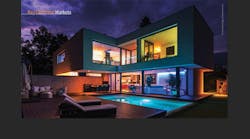The 6th Annual LightCongress, held recently at the Hotel Affinia, New York, offered lighting professionals and students a glimpse of the art, science and potential profits of lighting.
In his keynote address, Dr. Mark Rea, director of the Lighting Research Center at Rensselaer Polytechnic Institute, used LightCongress' theme, “Tomorrow is Today,” to spell out practical efforts that can help ensure sustainability. He urged attendees to consider the cradle-to-grave product cycle, and not just the lumen per watt efficacy of any light source. Rea said architects should incorporate daylighting and occupancy/control systems in building design whenever possible.
Another speaker, lighting designer Jim Benya, Benya Lighting Design, Portland, Ore., agreed that architects should consider passive measures such as daylighting before using active measures, and said it's easy for architects who don't have a background in green building design to make mistakes such as over-glazing a building, or not positioning it on a building site to maximize the use of the sun's rays to provide daylighting.
To help defer the cost of new and retrofitted lighting systems, building owners can still take advantage of federal tax incentives. Cheryl English, vice president of market and industry development, Acuity Brands Lighting, Atlanta, encouraged attendees to make use of the Limited Time Tax Incentives provision contained in the EPAct 2005 law. Under the Commercial Building Deduction, owners can write off the entire cost of new lighting in the taxable year it's placed in service in both new and existing buildings.
Another panel discussion at LightCongress looked into the synthesis between economics and the health of humans, hinting that “health per watt” might be substituted for “lumens per watt” in lighting design considerations to gain important benefits. Dr. Joan Roberts, chair of the Department of Natural Sciences, Fordham University, noted that new research makes it clear that we do not know as much as we thought about lighting. She said researchers are exploring the relationships among the visual, nonvisual photoreceptive and circadian (biological rhythm) systems in humans — the connections between light and health. They are studying how ganglion cells located in front of the human eye's retina detect light, how much light is needed for them to respond and their wavelength (color) sensitivity.
The next step is to apply that knowledge to tomorrow's lighting systems. It seems that blue (cool color) light during the day and reddish (warm color) light at night is most beneficial for our circadian rhythms, and that the color-changing feature inherent in the emerging light-emitting diode (LED) source has particular advantages.
Roberts said if lighting professionals know more about how the human eye perceives light, it may drastically affect future design criteria used for indoor lighting. A technical report by The National Renewable Energy Laboratory shows that a properly designed daylighting system decreases the incidence of headaches, seasonal affective disorder and eyestrain among office workers.
Osram Sylvania, the title sponsor for LightCongress, and supporting sponsors including Watt Stopper, Lightolier, Acuity Brands Lighting and LaMar Lighting, also showed some of their products during the event's evening reception.
The author has been covering lighting for Electrical Wholesaling and Electrical Construction & Maintenance magazines for more than 40 years and is respected as one of the most knowledgeable technical lighting writers in North America.








